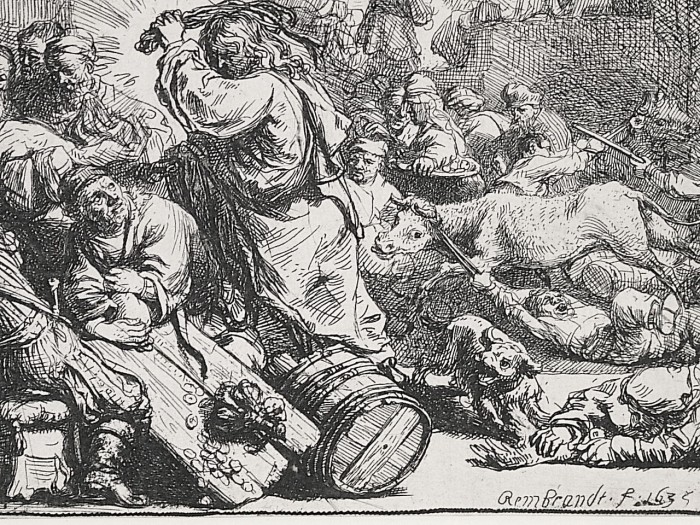Christ Driving the Money Changers from the Temple

Rembrandt Harmenz. Van Rijn (1606-1669), Christ Driving the Money Changers from the Temple, etching and drypoint, 1635 [signed and dated in the plate]. References: Bartsch 69, White/Boon first state (of 2); Nowell-Usticke first state (of 7). In excellent condition, trimmed outside of the borderline inside the platemark all around, 5 7/16 x 6 3/4 inches, archival mounting.
A superb black impression, with exquisite detailing. Although common in worn, clotted late impressions, lifetime impressions of this quality (as attested to by the distinguished provenance shown below) are of the utmost rarity.
Printed on old laid paper with a Strasbourg Bend variant A.c. watermark; this watermark is also found in the fine impression of the same print in the Museum of Fine Arts Boston collection (#151, the show Rembrandt’s Journey, MFA, Boston).
Provenance:
Johann Andreas Boerner, Nuremberg (Lugt 269) with an inscribed date of 1815
Wilhelm Edouard Drugulin, Leipsiz (Lugt 2612)
Dr. August Strater, Aachen (Lugt 787)
P. von Baldinger-Seidenberg, Stuttgart (Lugt 212)
Frederick Keppel and Co., New York
The etching shows the state of pandemonium in the Temple as Christ, in a scene described by all four evangelists, drives out the moneychangers, wielding a “scourge of small cords” (John 2: 15). In the Temple Christ had found “money changers sitting” as well as those who sold “oxen and sheep and doves”; in the print we can see a man being dragged across the floor by an ox at the right, another diving after a dove (lower right). As his bench falls over a man grasping a bag of money looks up at Christ; at the end of the table change falls to the floor. At the left men finish up their trading, one carries a basket of doves on his head as he and others rush out. In the background, in peaceful contrast to the foreground riot, a religious service – perhaps a Bar Mitzvah (a small boy prays before a group of men) – continues unabated.
Rembrandt borrowed the figure of Christ from Durer’s engraving of the same subject (in the Small Passion); it is a close reverse copy. In the engraving light emanates from a candle; in Rembrandt’s etching the light comes from Christ’s raised hand.
